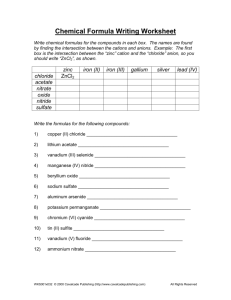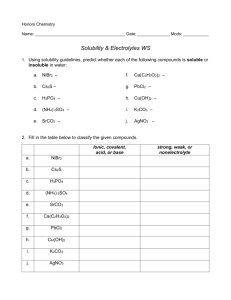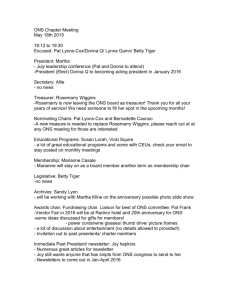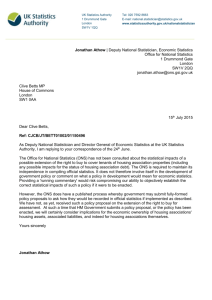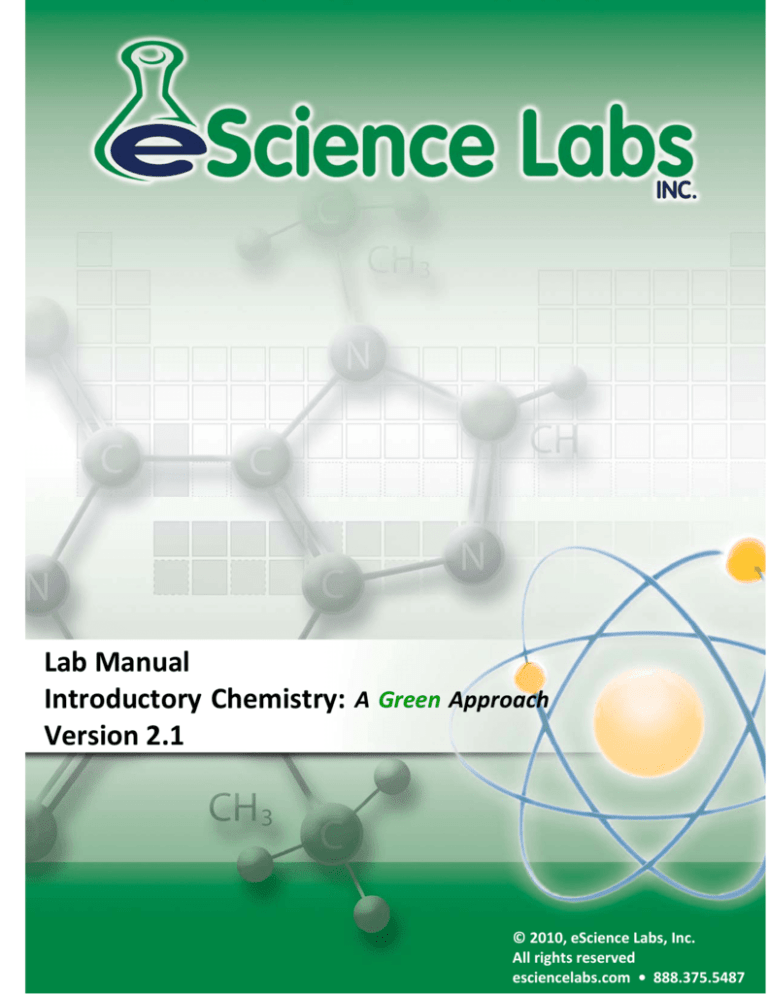
Lab Manual Introductory Chemistry: A Green Approach Version 2.1 © 2010, eScience Labs, Inc. All rights reserved esciencelabs.com • 888.375.5487 Table of Contents Chemistry and Experiments Lab 1: Introduc on and Safety Lab 2: The Scien fic Method Introducing Chemical Reac ons Lab 3: Chemical Reac ons I Lab 4: Chemical Reac ons II Lab 5: Metals and Oxida on Classifica on of Elements Lab 6: The Mole and Avogadro’s Number Lab 7: The Periodic Table Lab 8: Stoichiometry Gas Laws Lab 9: Ideal Gas Law Reac on Rates Lab 10: Reac on Rate Lab 11: Catalysts Acids and Bases Lab 12: Acids and Bases Lab 13: Titra on 3 Introductory Chemistry Lab 3: Chemical Reac ons I Lab 3: Chemical Reac ons I Concepts to explore: Understand qualita ve tests for ions that are based on solubility Learn that Na+, K+, NH4+, NO3–, and CH3COO– are water soluble Recognize balanced chemical equa ons Qualita vely test for fluoride ions in mouth rinses Introduc on Have you ever wondered how toothpaste helps prevent cavi es? Remember your last visit to the den st to have your teeth cleaned and a check‐up? You most likely waited anxiously as the den st finished checking your teeth and breathed a big sigh of relief if he pronounced, “No cavi es!” But what caus‐
es cavi es anyway, and how does brushing your teeth help to prevent them? Your teeth, like many other bones in the body, are mostly made of a substance called hydroxyapa te. The empirical formula of hydroxyapa te is Ca10(PO4)6(OH)2. Plaque organ‐
isms that live in your mouth produce acids that dissolve min‐
Figure 1: Brushing with a fluoride toothpaste can help prevent erals, such as the calcium and phosphorous found in hydrox‐
tooth decay. Fluoride mouth rinses are also popular dental yapa te. The ac ve ingredient in toothpaste, fluoride, help hygiene products that contain fluoride. Other products in‐
replace those lost minerals. It has been found that the hy‐
clude fluoride gels and foams that are applied to teeth for a droxyapa te in your teeth can easily replace lost minerals period of me. with fluoride. Because of this, a tooth’s crystal structure that has incorporated fluoride is more resistant to decay than the original structure, which is why we need to brush our teeth with toothpaste that contains fluoride every day! Figure 2: Diagram showing the molecular structure of a nitrate ion (NO3‐) Ions have very different chemical and physical proper es than atoms. For in‐
stance, fluoride (F‐) as an ion is safe enough to add to drinking water and toothpaste to help prevent cavi es; while fluorine (F2) is a very poisonous gas. Throughout history, scien sts have developed many ways to test for the pres‐
ence of different types of ions. These are called qualita ve tests. In many of these tests, one ion replaces another to produce a solid precipitate. There are also some useful generaliza ons that can help a chemist know whether or not a par cular chemical is soluble in water. One of the useful solubility rules for ionic compounds states that compounds containing Li+, Na+, K+, or NH4+ are soluble in water. The water solubility of many other compounds can also be found in handbooks. 35 Lab 3: Chemical Reac ons I You can see that nitrates (NO3‐), acetates (CH3COO– or C2H3O2‐), and ammonium ions (NH4+) all have a charge like the fluo‐
ride ion, but they are made up of more than one atom. These are called polyatomic ions, which are molecules with a net charge. Calcium acetate can be used to qualita vely test for the existence of fluoride in a solu on. This relates to another im‐
portant solubility rule, which states that nitrates and acetates are water soluble—therefore calcium acetate, Ca(C2H3O2)2 , is soluble in water. A solu on of calcium acetate will react with fluoride to make calcium fluoride, which is not very soluble in water and will form a solid precipitate that is easily observed. Chemists have a short way to write out what is happening in a reac on. It is called a chemical equa on. The chemicals that are reac ng are called the reactants and placed on the le side of an arrow. The chemicals that result from the reac‐
on are called products and are placed on the right side of the arrow. The reac on that you will be observing in this lab can be wri en as the following chemical equa on: 2 NaF(aq) + Ca(C2H3O2)2(aq) CaF2(s) + 2 Na (C2H3O2) (aq)
The abbreva on “aq” by the chemical formula stands for “aqueous,” meaning that reactant or product is dissolved in wa‐
ter, while the “s” indicates that the substance is a solid. This chemical equa on has also been balanced. This means there is the same number of each of the different atoms on either side of the equa on. This may not be very clear when you first look at it. No ce that there is a 2 in front of the NaF and no number in front of the Ca(C2H3O2)2. A number in front of a molecule, such as the 2 in front of the NaF, is called a coefficient. A coefficient of 1 is usually not wri en, but can be assumed. As you can see, one molecule of a sub‐
stance does not always react with just one molecule of another sub‐
stance. The coefficients tell us the ra o of how the molecules react. In this reac on 2 NaF react with 1 Ca(C2H3O2)2. Figure 3: A three‐dimensional model of an acetate (CH3COO‐) anion—can you iden fy the structures pictured above? A subscript a er an element’s symbol in a chemical formula indicates the quan ty of atoms of that element in the compound. For example, the CaF2 molecule has one calcium (Ca) and two fluorine molecules (F). This is also true for polyatomic ions. In Ca(C2H3O2)2, the ion (C2H3O2)‐ is in parentheses and has a subscript 2. This means there are two (C2H3O2)‐ ions in calcium acetate. You can think of it as a shorter way of wri ng Ca(C2H3O2)( C2H3O2). In total, Ca(C2H3O2)2 has one Ca atom, four C at‐
oms, six H atoms, and four O atoms. If a molecule with a polyatomic ion in it does not have it in parenthesis it means that there is only one of them for each molecule. The NaC2H3O2 has only one (C2H3O2)‐ . Now that you know how a chemical equa on is wri en, you can count the number of each elements on the reactants side and on the products side for the reac on above. Did you get 2 Na, 2 F, 1 Ca, 4 C, 6 H, and 4 O on each side? If so, you are correct! Since there is the same number of each atom on both sides of the arrow, the chemical equa on is balanced. 36 Lab 3: Chemical Reac ons I Pre‐lab Ques ons 1. Name the chemical that makes up teeth. 2. How does plaque harm teeth? 3. How does fluoride promote dental health? 4. Write two solubility rules that are used in this lab. 37 Lab 3: Chemical Reac ons I Experiment: Ba le of the Mouth Rinses Some mouth rinses also contain fluoride, usually in the form of sodium fluoride which is soluble in water. In this lab, you will determine which one of two mouth rinses would be be er at preven ng cavi es by replacing lost minerals with fluo‐
ride. You will do this by determining which mouth rinse contains fluoride. Materials Safety Equipment: Safety goggles, gloves Mouth rinse A (10 mL) Mouth rinse B (10 mL) 1 M Calcium acetate Ca(C2H3O2)2 Test tube rack 2 Test tubes 10 mL Graduated cylinder S rring rod Permanent marker Procedure 1. Label the two test tubes with a Sharpie: A, and B. HINT: Make sure to write down which rinse is A and which is B. 2. Pour 10 mL of Rinse A into the test tube marked A. HINT: If using the same graduated cylinder, rinse WELL to prevent cross contamina on. 3. Pour 10 mL of Rinse B into the test tube marked B. 4. Pour 3 mL of 1 M Ca(C2H3O2)2 solu on into each of the test tubes. Gently s r each test tube with a s rring rod to mix. Be sure to clean your s rring rod each me before placing it in a solu on. CAUTION: Mixing should be done gently to prevent glass breakage and injury. 5. Observe the reac ons for at least 10 minutes to insure it is finished. HINT: A posi ve test is indicated by a cloudy appearance of the solu on. The precipitate formed can be more easily seen if the test tube is held up to the light. The precipitate will eventually se le to the bo om of the test tube. 6. Record all observa ons in the Data sec on. 7. 38 To clean up, you can rinse the small amount of precipitate down the drain. Lab 3: Chemical Reac ons I Data Observa ons of NaF and Ca(C2H3O2)2 (See sequence of pictures below): Addi on of Ca(C2H3O2)2 to NaF; 57 seconds a er the addi on of Ca(C2H3O2)2 ; 20 minutes a er the addi on of Ca(C2H3O2)2 ; 35 minutes a er the addi on of Ca(C2H3O2)2 ; and 1 hour a er the addi on of Ca(C2H3O2)2 . Observa ons of Rinse A and Ca(C2H3O2)2 : Observa ons of Rinse B and Ca(C2H3O2)2 : 39

